Andrew Macarthy's Blog, page 14
May 11, 2017
How to Respond to Negative Reviews on Facebook to Win Back Angry Customers to Your Business (With Examples)
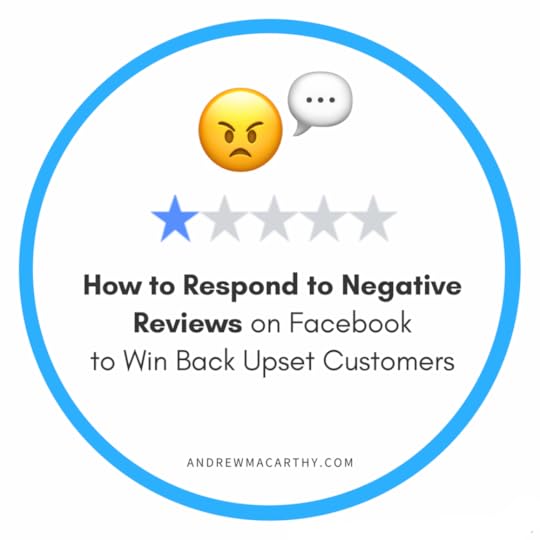
Why People Post Reviews Online and Why You Every Business Should Respond
There are plenty of reasons why customers choose to post reviews to your Facebook Page or other social media site, but they largely fall into two camps - to share a positive experience or to complain very publicly. Good and bad reviews on Facebook or elsewhere can make and break your brand, but how you respond to them can be just as important.
Many brands tend not to reply to any review, regardless of its sentiment - and they're missing out! Every review is an opportunity to learn about how you conduct your business, who your audience is, and the chance to build long-term relationships with customers whether their comments were full of praise or not so kind.
What's more, the sheer visibility of reviews and star-ratings have a huge impact on whether a person will decide to use a business or not. That doesn't mean necessarily that a consumer won't consider using a business unless they have a perfect 5-star rating - most people know that no business is perfect and don't get everything right ALL of the time. However, they are looking for a business that they can trust - and approaching reviews from a business perspective in the right way can go a long way to fostering that trust.
These figures show the importance of online reviews:A third of customers post online following inadequate customer service, sharing comments about your brand to their network and beyond (New Voice Media) 88% of people read reviews to determine the quality of a local business (Bright Local)87% of people say that a business need a rating of 3-5 stars before they will use them.52% of customers expect to hear back from brands within 7 days of giving an online review, particularly one that’s negative or critical. (Review Trackers)72% of consumers say positive reviews make them trust a local business (Bright Local)When a brand responds to a customer on social media, 65% are more brand loyal and 25% percent are less likely to go somewhere else or post negative things (Sprout)In this blog post, I'll show you how best to respond to any review (negative, positive or neutral) - on sites like Facebook, Twitter, Yelp, etc., along with example responses that you can tweak to make your own. Let's go!
1. How to Respond to Negative Reviews on Social Media
People who have a negative experience are more likely to tell their friends and family about it. They'll hear it both in person and when the review is shared online. Meanwhile, ANYONE who visits your social page will be able to see that one-star rating and use it as an indicator as to whether they'll pay you a visit or steer clear.
Choosing not to reply and hoping that the issue will blow over is not recommended. Responding in the correct way to a bad review is a way to heal the hurt feelings of an upset customer and to help them and others see your brand in a positive light again. Picking up on individual keywords within a negative review is a really good way to think about formulating a personalised reply and encouraging a more positive outcome.
Write a short, non-confrontational reply that shows that you have read and understood the issue(s) raised, even if they are unfounded. Be specific and acknowledge the customer’s concerns; show sympathy that they had a bad experience.Sincerely apologise for the upset caused offer to make things right.Thank the customer for their visit and taking the time to provide feedback.Reassure them by explaining how the issue has been or will be resolved for the future. As a sweetener, you could offer a discount or freebie to welcome them back next time.Avoid including your business name and location in the reply, so that the negative review is less likely to be prioritised (and found) in search engines.EXAMPLE RESPONSE TO NEGATIVE REVIEW
[Customer Name],
Thank you for your comments. I’m very sorry to hear about your experience. This is definitely not the standard of service our customers have come to expect from us, [share what normally happens]. Please contact me, as I would like to make up for your disappointment. [Name, Job Title, Email Address and/or Phone Number]

When someone leaves a positive review for your business, you know instantly that they were pleased enough with their experience that they felt compelled to share their thoughts with you and their friends on social media. Responding to a positive review is a fantastic way to engage a customer further and build upon brand loyalty.
Thank the customer for their kind words, and for their visit or purchase. Be specific in your wording.Include your business name, location, and keywords within the response. Doing so will help the positive review appear in search results.
Invite the customer to do something. Ask the customer to return, use another service or spread the word.
Include your business name and location within your response to a positive review, as this will help it appear in help it to appear in search results.
If the opportunity presents itself (i.e. if the customer has hinted at it within their review), include information about upcoming sales, promotions or events for their benefit and anyone else who reads your reply - but read the signals on this one. The last thing you want to do is sour positive sentiment by appearing to be use it as an opening for blatant marketing.If you have identified them as a particularly loyal customer, reach out to them privately to offer a little reward for their generosity. EXAMPLE RESPONSE TO POSITIVE REVIEWHi [Customer Name], We’re so pleased that you enjoyed [something specific customer mentioned in their review], everyone at [business name] was so proud to hear such wonderful comments! Next time you’re here, you should try the [insert a feature or special], or join us for [upcoming event]. Thanks for leaving the positive review, I hope to see you again soon. Regards, [Business Name / Manager / Owner].
3. How to Respond to Neutral Reviews on Social Media
Research by Brandify found that, on average, neutral reviews make up half of all reviews received by retail brands, but only a fraction of these actually receive a reply. Neutral reviews give your brand the chance to nurture a part-satisfied customer into feeling more positive about your brand and more likely to visit you again in future.
According to the Harvard Business School, a one-star improvement on Yelp can translate to a 5-9% revenue increase.

Neutral reviews (three star rating) will include a mixture of positive and negative sentiment. Whether the negative portion is concerned, you should treat it in your response it as if it was a one star review. While the feedback might not be wholly positive, take the time to respond. Doing so shows that you genuinely appreciate customer feedback and are eager to seek their full approval in future.
If the customer has highlighted a problem to which you know the solution, thank the customer for their feedback and explain how you aim to improve service in future.Like with a negative review, don't be afraid to offer a coupon or discount to entice them back. Alternatively, you can remind the customer of new products, offerings, or events in the pipeline that may be the perfect time to invite them to try you again - and to prove that you can meet their full expectations.Social Media Review Responses: Additional tips and strategiesAsk for reviews50% of consumers say will leave a review for a business if asked, reinforcing the need for virtually every business to have a reputation marketing strategy. You can request that customers leave reviews in plenty of ways - in person at your store, on the bottom of a receipt or email, marketing material that comes packaged with your product, etc. Timing is key! Present the opportunity at the point where your customer is most likely to be pleased at the service they have received.
Bury negative reviews with positive onesYou may be able to persuade a once-unhappy customer to update their negative review to a more positive one, but chances are that most will not and you'll be stuck with it. And since most review sites don't allow businesses to delete bad reviews, your next goal should be to drown it in a sea of great four- or five-star reviews. Use the tips above about encouraging reviews and over time, the positive reviews will drown out the negative ones. Any future customers reading reviews will see the bad ones as more of a one-off, and not the norm for your business.
Keep review replies shortIn general, you should try to keep all review replies short and succinct - t three sentences for your whole reply is a good rule of thumb.. Remember, it's not just the reviewer who will read your reply, but all other potential customers. If your responses aren't easy to digest, then they might simply move onto a competitor. In regards to bad reviews in particular, don't go into too much detail or ask any questions. This will prevent you saying something that might cause the disappointed customer to add more negative feedback by replying to your comment. If your response needs to be long, offer to take the conversation private and contact the customer one-to-one.
Respond to reviews as fast as you can manageResponding to reviews quickly lets customers know that you are attentive and considerate to their thoughts. When a customer has left a review (particularly if it was negative), they may bait you with questions and be actively waiting for a response. If it's not possible to drop everything and reply during your average work day, don't sweat it, but do try and set aside some time in a day to respond to all reviews and other customer comments.
Over to youI hope this post has given you lots of good advice to help you deal with all types of reviews on social media, and how to turn any type of customer feedback into an opportunity to grow engagement and brand loyalty. Let me know what you think in the comments below!

Andrew Macarthy is a social media consultant and the author of the #1 Amazon Web Marketing Bestseller, 500 Social Media Marketing Tips.
Buy 500 Social Media Marketing Tips
Amazon US: http://www.amazon.com/dp/B007L50HE6
Amazon UK: http://www.amazon.co.uk/dp/B007L50HE6
Follow Me:
http://www.fa
cebook.com/50
0socialmediatips/
http://www.pinterest.com/andrewmacarthy
http://www.twitter.com/andrewmacarthy
April 19, 2017
April the Giraffe: 7 Lessons Your Brand Can Use to Make the Next Viral Hit on Social Media

April the Giraffe and the birth of her calf at the Animal Adventure Park in upstate New York, was an internet phenomenon. At any given moment, up to 200,000 people were watching the live stream at all hours of the day, in the build up to the big moment; the video was first switched on back in February.
Live video allows people to feel they are a part of the experience, and thousands of people were glued to their screens for weeks, watching and waiting with great anticipation. With the calf now born, here are 7 lessons that every brand can learn from the live stream of April the Giraffe.
1. Your everyday is other people's extraordinaryAs we go about our daily routines, especially at work, we never really stop to think that some of the "ordinary" things we will seem fascinating to other people. To a zookeeper, for example, the birth of a giraffe, while special, will not be something they haven't seen before. Compare this to the average person, to whom the chance to view the live birth of a cute, baby giraffe is something that doesn't really ever happen. In addition to this, April was some two months overdue - very usual - which made viewing that much more compelling.
Key takeaway: What is your ordinary that others would find extraordinary?
2. FOMO - Fear of Missing Out
Hi! My name is Jenn and I'm addicted to watching April the giraffe. Can't stop. Won't stop. Thanks. I'm grateful to find my people.
— Jenn Satterwhite (@javajenn) April 13, 2017
When it comes to the delivery and sharing of news via social media, there's a currency amongst users who like to be the first to know, to see an event happen live, and tell their friends - and definitely not be the last. The key attraction of "Giraffe Cam" was a fear of missing out. Fans were glued to the live stream or checked in multiple times a day at the very least, to check on April's progress.
Key takeaway: Generate a FOMO to keep fans glued to your content.
3. The power of authenticityThe phenomenom of April the Giraffe's live stream (and all of the money-making merchandise sold as a result) was not planned and executed by a gaggle of highly-paid marketers and advertisers. The idea was thought up and launched by a small staff or hourly workers at the Animal Adventure Park. While Toys R Us ultimately sponsored the feed, its largely organic spread and genuine authenticity in the story, was a strong part of what captivated and appealed to viewers.
Key takeaway: Never underestimate the marketing power of authenticity.
4. Work with partners to generate more reach
When April reached her full-term of 15 months of pregnancy, Toys R Us were quick to seize on the opportunity to sponsor the live stream - their logo a permanent fixture on top of the live feed from that moment forward.
"We quickly became mesmerized (some might even say obsessed!) by #Aprilthegiraffe and were thrilled to join the millions of people from around the world who had been watching the live video feed from the Animal Adventure Park," Amy von Walter, a spokesperson for Toys "R" Us, told Fortune. "Our team reached out to the Zoo and we were able to agree on a sponsorship immediately."
It was a win-win deal. April the Giraffe provided the retailer with a continuous marketing campaign and a huge captive audience. Meanwhile, Toys R Us shared the story far and wide on its own social channels, and created additional content to support the whole event.
Key takeaway: Invite or reach out for support from key strategic partners as a way to bolster your campaign.
5. Create a variety of content in supportApril's live stream might primarily have centered on YouTube, but the park didn't just stop there, using the event as a way to boost engagement on other social channels. This included daily updates on Facebook and Instagram, including photos, videos, and Q&s.
Key takeaway: Generate more buzz via other social channels.
6. Don't forget a call to actionIf you find yourself with a successful, ongoing campaign on your hands, keep in mind your overall marketing objective and ask people to take action. If it's just to build brand awareness, you're pretty much there, but if you have a product to sell, want to collect leads, or generate interest in something else, make sure to tell your now-engaged (and hopefully receptive) audience! In the case of April the Giraffe, Animal Adventure Park placed a link to their Giraffe Emoji app in the description, as well as a link to donate to the organisation’s GoFundMe page.
Key takeaway: Keep a level head despite the excitement of a social media hit, and funnel fans towards helping you achieve your business goals.
7. Capitalise on success for continued growthOnce a successful campaign has come to an end, aim to keep the momentum going for as long as you can with new, spin-off ideas. Now April's calf is born, you can be sure that people will be just as invested in her progress - choosing its name, growth, how it's settling in at the park, etc. As a result of the success of bringing April’s story to the world, Jordan Patch, Animal Adventure Park owner, has admirable intentions, telling Blooloop:
“As for our strategy in the future, we are going to take a more global approach. We’re going worldwide. We’re going to produce online educational videos and make those an available resource for teachers and other people who would like to use them for educational value.”
Key takeaway: Think about how you can build on the success of a social media hit.
Over to youWere you glued to watching April the Giraffe's live stream? Did the strategies above give you inspiration for your own content strategy? Let me know in the comments below!

Andrew Macarthy is a social media consultant and the author of the #1 Amazon Web Marketing Bestseller, 500 Social Media Marketing Tips.
Buy 500 Social Media Marketing Tips
Amazon US: http://www.amazon.com/dp/B007L50HE6
Amazon UK: http://www.amazon.co.uk/dp/B007L50HE6
Follow Me:
http://www.fa
cebook.com/50
0socialmediatips/
http://www.pinterest.com/andrewmacarthy
http://www.twitter.com/andrewmacarthy
April 12, 2017
8 Positive Ways Social Media Influencers Can Grow Your Brand
Are you considering introducing influencer marketing as part of your content strategy on Facebook, Instagram, or other social network?
Brands have plenty to gain by engaging in influencer marketing. Working with the right influencers can have a multitude of positive effects on your brands business. In this blog post, I'll share 8 reasons why influencer marketing can be a real asset. Let's go!
1. They Generate SalesOf course, one of the main reasons brands seek out influencers is as a means to generate sales. How you and an influencer decide to start edging people towards the sales funnel – and what part they might have in making sure customers’ stay in it - will be between you and them. In a survey by Linqia of 170 marketers, 89 percent are happy with the authentic brand content created by social media influencers, 77 percent cite brand/product engagement as key benefits and 56 percent report traffic to websites and landing pages as a key payoff.
2. They’re Inspirational Content MachinesThere’s good reason that influencers have large followings in the first place – they’re passionate about their interests, and have a proven track record at building and sharing content that resonates with their audience - expertise that you can tap into. By working with an influencer, you not only benefit from their reach, but have the ability to share in their honed-in eye for successful social media posts, either on their profiles or your own. Even after a project has finished, you’re sure to take away new ideas and strategies that you can run with on your own.
3. They Build Brand AwarenessGenerating sales might be the main goal of influencer marketing for many brands, but the brand awareness built within this process is unrivalled -. After all, how can something like a static advert or a press release for a product or service compete with a real life person with a real enthusiasm to talk about your brand to their audience? They’re perfect as a middle man to communicate your brand's vision and message in a way that will encourage followers to engage and connect.
4. Their Voice is TrustedAs I mentioned in the introduction to this book, consumers are proven to trust the opinion of their peers and influencers than a brand’s message alone. According to a joint study by Twitter and analytics firm Annalect, 47 percent of respondents said they had purchased an item online after seeing it used by an influencer on Instagram, Twitter, Vine or YouTube.
5. They Can Offer Great ROIWhen compared to traditional advertising and PR activity, collaborating with influencers still provides excellent value for money when your aim is to connect with a target market. In one study conducted by Tapinfluence, influencer marketing generated an unprecedented ROI. Working with White Wave Foods and Nielsen Catalina Solutions to track the in-store purchases exposed to influencer marketing, the results were staggering. They showed a total of $285 in incremental sales per 1000 impressions, some 11 times greater the expectations from a traditional digital advertising campaign. The study also revealed influencer marketing to be a surprisingly long tail, with new customers discovering the content months after the original post. Of course, this is likely to be the exception rather than the rule, but does show what can be achieved if you find the right influencer to showcase your brand in a way that resonates with your audience.
6. They Are Transparent and Reach Ad-Blind consumersAssuming that you agree with influencers that your participation with them will be made clear within any sponsored content (and you should), transparent influencer marketing can provide a fresh way to reach a growing number of people who mistrust traditional digital advertising. Consumers are more likely to be receptive to a promotional message when it is made known that they are being targeted. In a study carried out by Harris Poll for Lithium Technologies in 2016 , 74% of Generation Z (16-19 year-olds) and millennials (20-39 year-olds) said they did not like being targeted by adverts via their social media feeds. However, while revealing that they are tired of being targeted and less receptive to adverts, 35% of 16-39 year olds also said they trusted celebrity endorsements, and 50% trusted blogs.
7. They Become Brand AdvocatesA one-and-done campaign with an influencer is perfectly all right, but if you develop a long-term relationship that goes beyond simple brand awareness and generating interest in your product, it’s then that the real value of having an influencer in your corner will show. The stronger your connection grows, the more your influencer will start to feel like a true brand ambassador, hopefully resulting in the kind of proud content that rubs off on your target audience.
8. They Can Grow Your NumbersAs well as an over-arching goal like driving sales, influencers can also have the very welcome side effect of driving traffic to your website (by sharing your blog posts), increasing your social following (by tagging your brand in their posts), and improving your SEO – by backlinking to your website on their blog, for example.
Do you work with influencers as part of your social media strategy? Or is it something you are looking to try? Let me know your thoughts in the comments below!

Andrew Macarthy is a social media consultant and the author of the #1 Amazon Web Marketing Bestseller, 500 Social Media Marketing Tips.
Buy 500 Social Media Marketing Tips
Amazon US: http://www.amazon.com/dp/B007L50HE6
Amazon UK: http://www.amazon.co.uk/dp/B007L50HE6
Follow Me:
http://www.fa
cebook.com/50
0socialmediatips/
http://www.pinterest.com/andrewmacarthy
http://www.twitter.com/andrewmacarthy
March 23, 2017
How to Add More Than One Clickable Link to Your Instagram Profile Bio

How to Add More Than One Clickable Link to Your Instagram Profile BIo
Instagram's changed a lot over the past couple of years, but one feature has remained stubbornly familiar, especially to brands: you can only add one clickable link in your profile's bio.
As I write, that's still the case, but there is at least one neat little workaround that I wanted to share - Linktree. If like me you're fed up of constantly editing your Instagam bio link for different reasons, this tool is for you. Here's Linktree designer, Bolster's Alex Zaccaria, explaining the motivation behind the currently-free tool:
"We created Linktree because we got sick of constantly changing our instagram bio link when we had something new to share. We figured there should be a simple tool which allows you to put one link in the bio, leave it forever and then easily add, swap and change the links that are visible.
Especially now with Instagram's algorithm change, the posts users see aren't chronological. So a link currently in your bio may not be relevant to a post that your followers have read! Linktree allows you to link to multiple links so you can always have relevant content on display."
Here's how Linktree works in practice:
You place a link in your Instagram bio as normal, but it is tied to your Linktree account: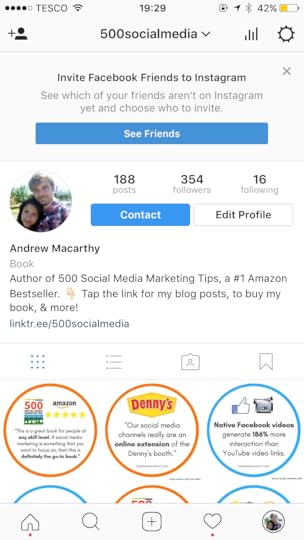
Your bio should encourage fans to click on theLinktree link, and when they do, they'll be taken to a neat list of custom-made links at your Linktree account:
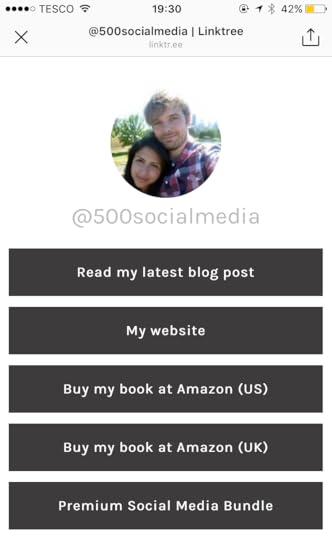
As you can see my example above, my Linktree account has clear buttons directing fans to my latest blog post and books. The setup is really easy, too. Here's how it goes:
1. Visit Linktr.ee and sign up using your Instagram login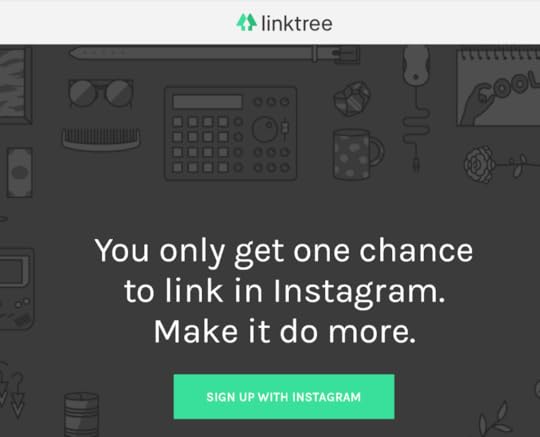
2. Build your link buttons
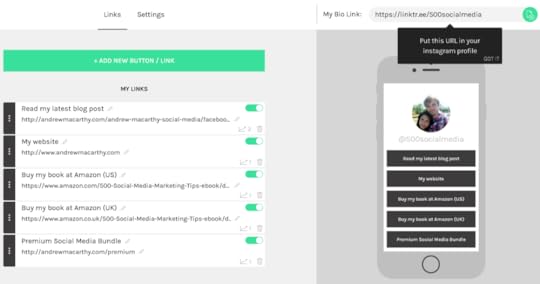
Once you're logged in, simply use the Add New Button / Link option to begin creating custom link buttons. Give each button a title and URL and feel free to drag and drop them to re-order them as you please.
3. Customise your link tree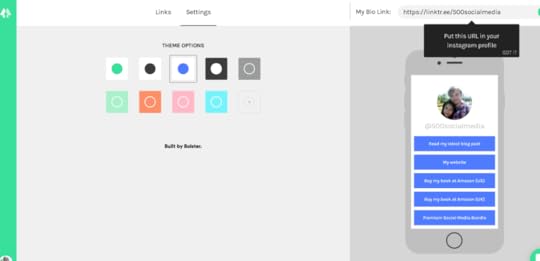
At present, Linktree's Settings only allow you to customise the look of your buttons with a handful of preset colours (although cutom theme options are in the pipeline). You'll see a live preview of your Linktree on the right-hand side. When you're done, copy your custom Linktree URL and paste it into your Instagram bio.
Tracking your LinktreeOnce your Linktree starts getting clicks, you'll see a chart showing the number of clicks beneath the link within your Linktree account.
Over to youThat's about it for now! Linktree is still pretty new, but its developers are hard at work in an attempt to add new features (including custom URLs) as soon as possible. An alternative solution to the one-link-only issue of Instagram would be to set up a page for links on your own website and share the page on your Instagram profile, but I do like the simplicity of this tool. What do you think? Will you be giving Linktree a try? Let me know in the comments below!

Andrew Macarthy is a social media consultant and the author of the #1 Amazon Web Marketing Bestseller, 500 Social Media Marketing Tips.
Buy 500 Social Media Marketing Tips
Amazon US: http://www.amazon.com/dp/B007L50HE6
Amazon UK: http://www.amazon.co.uk/dp/B007L50HE6
Follow Me:
http://www.fa
cebook.com/50
0socialmediatips/
http://www.pinterest.com/andrewmacarthy
http://www.twitter.com/andrewmacarthy
March 15, 2017
Want More Facebook Reach? Motivate Fans to REACT. Here's How and Why to Do It

Want More Facebook Reach? Motivate Fans to REACT. Here's How and Why to Do It
Do you encourage fans to react to your Facebook posts? I'm talking about these things:

Facebook introduced its now-familiar set reactions in early 2016 as a way for users to express themselves beyond a simple "like".
As you might know, Facebook's algorithm assigns a different value to actions that users take in the News Feed, and adds these up to determine how many people will eventually be shown a post you publish. When reactions were first rolled out, Facebook explained that they would each given the same value as a like:
"In the beginning, it won’t matter if someone likes, “wows” or “sads” a post — we will initially use any Reaction similar to a Like to infer that you want to see more of that type of content. Over time we hope to learn how the different Reactions should be weighted differently by News Feed to do a better job of showing everyone the stories they most want to see." - Sammi Krug, Facebook Product Manager.
Notice that last sentence! Just over a year later, and now Facebook says that reactions will, indeed, now be worth more than a like:"Over the past year we've found that if people leave a Reaction on a post, it is an even stronger signal that they'd want to see that type of post than if they left a Like on the post. So we are updating News Feed to weigh reactions a little more than Likes when taking into account how relevant the story is to each person."
Note: Facebook notes that currently all reactions are weighted the same, so News Feed's algorithms won't be influenced based on how someone reacts.
Use of Reactions are on the rise, tooA study by Quintly of 105,000 Facebook brand pages in May and June 2016 found that while Facebook Reactions made up just 6% of total post interactions, their use was increasing. The only reaction that decreased in the analyzed period was the established like – by 1%.
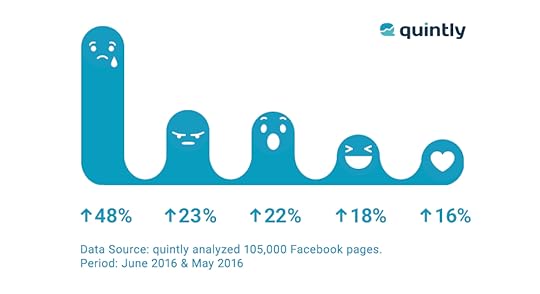
Quintly surmises that:
"Facebook Reactions are a highly valuable feature for social media marketers since engagement with a post is one of the most important elements of linking customers to a brand."
What does this mean for businesses on Facebook?In short, getting fans to react to your posts just got that bit more important - more reactions should hopefully generate improved reach for your posts. Perhaps your predominent content type already drives a strong reaction from fans:
Like anger, or sadness:
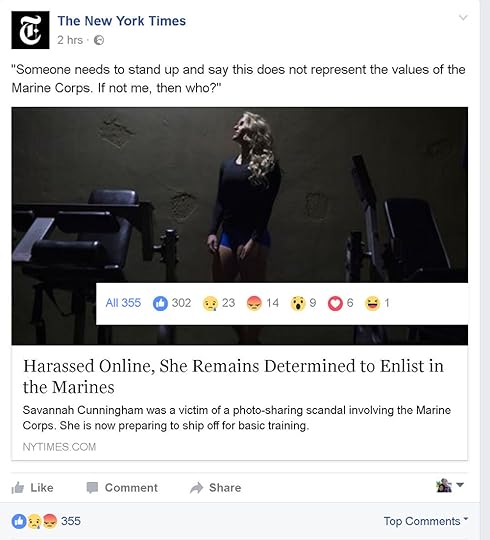
Or shock and awe:

But if your content doesn't make fans feel and react strongly on face value, there are other ways to encourage it:
Use your caption and image to prompt fans into reacting a certain way. In the example below, the Ha-ha reaction and "LOL" are used in the image itself to almost subconsciously drive users into selecting that reaction:
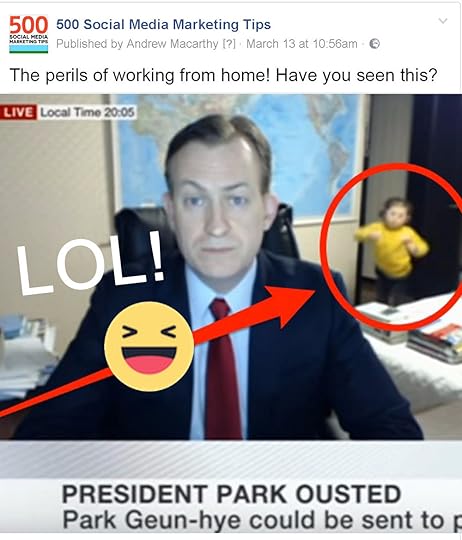
Alternatively, you could ask users to react as a way to answer a simple question. In the example below, users can react to express how they feel when Monday morning comes around...
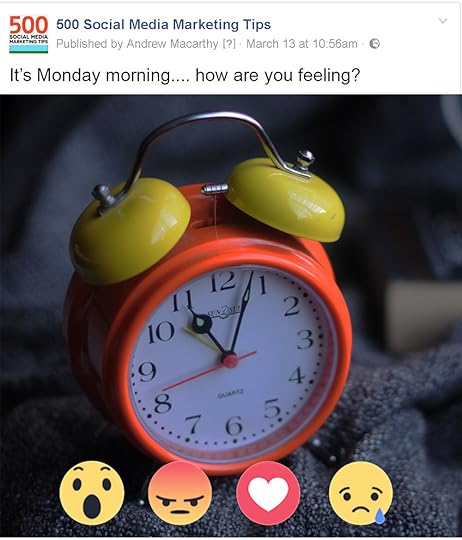
And don't forget video
Although I've shown image post examples above, if anything, video posts + reactions could be where the most striking benefits are to be found. In the same Quintly study noted above, it found that videos received a massive 60% more reactions than image posts. Quintly explains why this might be the case:
"For the consumer, images are easier and most of all faster to digest. Thus a “quick” interaction is stirred. When users spend more time watching a video, the brand message or information can be communicated in a more precise way than in an image. After watching the video, users seem to have a greater propensity for taking more time to express their feelings in a more detailed way by selecting a reaction and not by simply clicking the like-button."
In short, don't forget to drive reactions in video posts, too.
Over to youAlthough "likes" still win out as a choice amongst Facebook users, the popularity of reactions is growing steadily. Now, with Facebook nudging their value above "likes", now could be a great time to experiment with ways to encourage fans to show you how your posts really make them feel.

Andrew Macarthy is a social media consultant and the author of the #1 Amazon Web Marketing Bestseller, 500 Social Media Marketing Tips.
Buy 500 Social Media Marketing Tips
Amazon US: http://www.amazon.com/dp/B007L50HE6
Amazon UK: http://www.amazon.co.uk/dp/B007L50HE6
Follow Me:
http://www.fa
cebook.com/50
0socialmediatips/
http://www.pinterest.com/andrewmacarthy
http://www.twitter.com/andrewmacarthy
February 25, 2017
7 Ways Your Brand Can Leverage Multiple Image Posts on Instagram (Carousel Examples)

7 Ways Your Brand Can Leverage Multiple Image Posts on Instagram (Carousel Examples)
This week, Instagram rolled out a new "carousel" feature to its app. Users can now choose up to 10 photos or videos (or a combination of the two) to feature in a single post. As Instagram explains:
"You no longer have to choose the single best photo or video from an experience you want to remember. Now, you can combine up to 10 photos and videos in one post and swipe through to see them all.

When uploading to your feed, you’ll see a new icon to select multiple photos and videos. Once uploaded, you can tap and hold to change the order, apply a filter to everything at once or edit one by one.
This new feature has been available for just a few days, but already we're seeing examples of fun and inventive ways that brands are using multiple images and videos to create interesting and engaging content. In this blog post, I'll show you a number of examples for inspiration. Let's go!
1. Show a step-by-step processIn the blog post to announce this new feature, the first idea Instagram recommends for multiple image posts is to show a step-by-step process - and they're not wrong, it's a really elegant way to do so - a product demo, a recipe, or whatever you like. In the above example, @eatchowdrinks shows us how to make (and drink) a cocktail.
2. Explore a panoramic photoIf you want your fans to explore an image that doesn't fit the square format on Instagram, multiple photos (that being one large photo split into sections), let you do that. In the above photo, @returnofthecaferacers showcases the front, middle, and back of a motorbike.
3. Showcase multiple productsBefore this new feature, the only way to showcase multiple products in a single post was to split the frame up into pieces. Now, though, you have the freedom to highlight several items without forcing fans to squint in order to see them properly. In the above example, @samsungsrbija shares images of four products from across its ranges.
4. Ask a multiple choice question (fan survey)One of the most useful aspects of any social media is the ability to receive instant feedback on any kind of business decision. Multiple Instagram images allow you to ask a multiple choice question, using each image to display a choice and asking fans to comment below with their answer. In the above example, @holisticsky asks fans to vote on the logo design they like best.
5. Share an inspirational quoteI don't know about you, but there's something really satisfying about swiping or tapping to reveal quotes or sayings in their entirety. Multiple images on Instagram allow you to create this effect, like @a_book_of_words has done above.
6. Incorporate video and animationAs I mentioned above, "carousel" posts on Instagram allow you to use photos, videos, or a mixture of the two. Check out how @secondfacelyon uses video both to show off its new website and prompt users to swipe left using an animated arrow.
7. Tell the story of a dayIf Instagram Stories lets you curate a tale about your day as it unfolds, multiple image posts allow you to present a more polished overview for your feed. Pick the best photos or videos to sum up the events over a day and present them to your audience in one succinct post. In the above post, @egrrobotics5980 uses images to give fans an overview of its Girls Robotics Brunch.
Over to youWill you be using "carousel" posts on Instagram? What ideas do you have for them? Let me know in the comments below!

Andrew Macarthy is a social media consultant and the author of the #1 Amazon Web Marketing Bestseller, 500 Social Media Marketing Tips.
Buy 500 Social Media Marketing Tips
Amazon US: http://www.amazon.com/dp/B007L50HE6
Amazon UK: http://www.amazon.co.uk/dp/B007L50HE6
Follow Me:
http://www.fa
cebook.com/50
0socialmediatips/
http://www.pinterest.com/andrewmacarthy
http://www.twitter.com/andrewmacarthy
February 10, 2017
7 Tips to Help You Record Amazing Vertical Video For Social Media (With Real Business Examples)
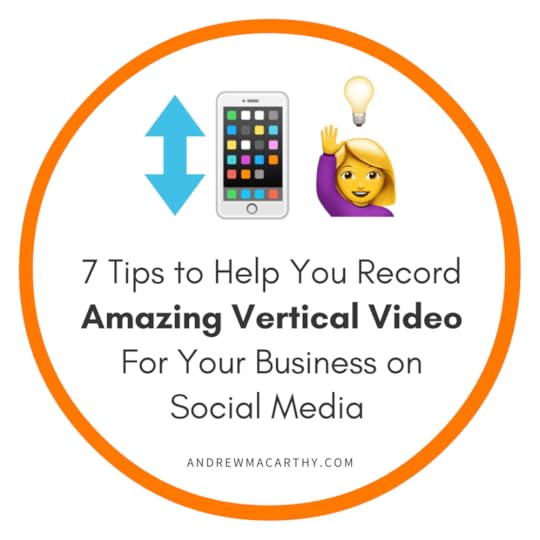
7 Tips to Help You Record Amazing Vertical Video For Social Media (With Real Business Examples)
In my last blog post, I explained five reasons why your business must start recording vertical video for business. Assuming you're now a vertical video convert, this blog post details seven ways to make your vertical video as engaging as possible. If you missed my last post, here's a re-cap on the benefits of vertical video:
Quick re-cap: why record vertical video?As consumers mostly always hold their smartphones vertically (94% of the time according to the MOVR Mobile Overview Report), when vertical video plays, it takes up the entire mobile screen, which provides more visual real estate to tell a more compelling story. According to Eric Blattberg of Digiday, marketers who once dismissed vertical video as an amateurish mistake are rapidly shifting their thoughts. “That’s in large part due to changing consumption habits that are making mobile the norm rather than the exception.”
Snapchat has spearheaded the use of vertical video in social media (with Facebook and others following), but huge brands and corporations, including the BBC, are now on board:
“Telling a story in this format makes it more personal,” said BBC creative director, Ryan O’Connor, as the corporation launched vertical video for its news reporting in January 2017. “There’s a FaceTime-like quality to the way it frames people…it [allows us to] connect to a story in a different way while appealing to different audiences.”
And some of the latest data backs up the growth in vertical video, too:
• Millennials are twice as likely to be focused on video they watch on their mobile devices as they are on video consumed on a TV.
• Vertical video ads are watched all the way through 9x more horizontal video ads on Snapchat, and over 7 billion video clips are viewed daily on Snapchat, the majority which are vertically filmed.
• According to Mary Meeker’s 2015 Internet Trends, vertical viewing now accounts for 29% of view time, compared to 5% just five years ago. (Source: KPCB)
And now, let's look at how to make the most of vertical video:1. Choose suitable subjects

One of the biggest criticisms of vertical video in the past was that it dramatically crops the subject being filmed, robbing the audience of a full-framed experience. It's true, many subjects are best filmed horizontally - but not all. Hold a camera sideways at a skyscraper, a giraffe, or a tall friend, and viewers certainly won't see the whole picture without some awkward up-and-down camera panning.
When filming vertical videos, look for subjects and settings that specifically fit the narrow frame, or look to explore anything that will delight or surprise when seen from a vertical perspective. Backgrounds such as entrance ways, trees, mountains, corridors, tunnels, and skylines take on a whole new visual appeal when seen in 2:3. Meanwhile, single subjects in the foreground - like a person talking into camera - will fill the whole frame with no wasted space.
Vervid sums this advice up well: "When shooting in vertical, creators need to consider the way an image moves across the screen — where it enters, where it exits, and what subjects make the most sense in this orientation."
2. Keep vertical videos shortPeople viewing videos on mobile devices are on-the-go and constantly interrupted by various notifications. As such, they're likely to consume content in multiple short bursts throughout the day. With attention spans getting shorter, consumers expect mobile video to be compact, short and viewable without much effort (if it's a mobile ad, no one is going to turn the screen 90 degrees to view it!). Matevž Klanjšek, CPO and Co-Founder, Celtra, explains the case for short vertical video well: “Short form vertical video[s] are designed specifically for a mobile environment. They both offer a bite-sized, instant and extremely impactful branding experience that fully leverages the mobile screen and is at the same time rewarding and enjoyable.”
To some factual context, Mary Meeker’s 2016 Internet Trends report found that a 10-second ad Snapchat ad for Spotify delivered a 30% lift in subscription intent and was twice as effective compared to typical mobile channels.
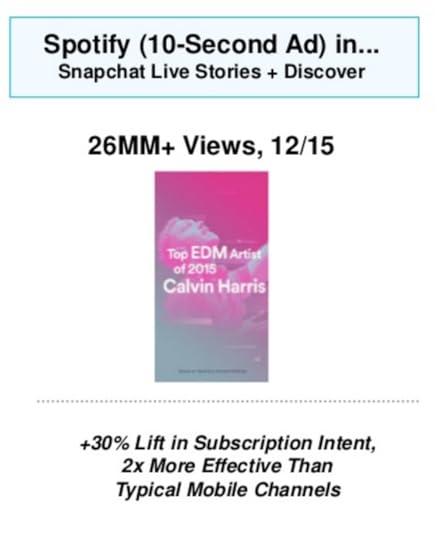
3. Composing your shot: the rule of thirds still applies
As with horizontal camera work, the rule of thirds still often works well to frame your subject in a pleasing manner when you're shooting vertically. If you aren't familiar with the rule of thirds, Atomic Learning it succinctly:
"The rule of thirds states that you should mentally divide the frame into thirds, both vertically and horizontally. What you get is like a tic-tac-toe board overlaying your screen. When you shoot your video, according to this rule, you should place your key subject elements along those lines. Where the lines intersect will be the best place for your subject."
Be aware that most mobile apps don't include a Rule of Thirds gridline overlay for their video modes (as they often do for photos), so you'll just have to do your best, re-shooting if necessary.
4. Get close in on details
When you're working with vertical video, especially films designed for short attention spans, you haven't always got time to establish a scene like you might in a longer, horizontal film. In addition, you're catering to people looking at smartphones whose display size is relatively small compared to a desktop or television. So, think about shooting video that immediately focuses on your subject matter and, if it plays to the strength of your message, zooming right in on the fine details.
5. Keep text away from the edges

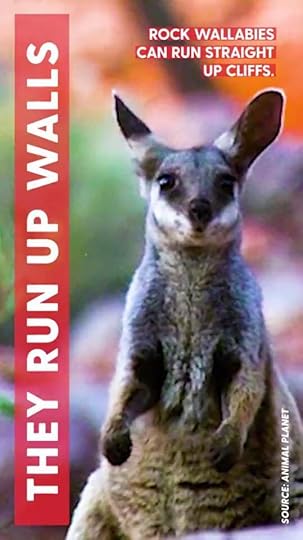
Adding text overlays or captions to vertical video is an extremely popular strategy for brands. Not only is text easy to read on a vertical display (mirroring the format in which we read books), but captioned videos also appeal to a large percentage of mobile users who - in public - will be viewing the video without audio. That said, do keep any text away from the extreme edges of the frame (centered is a good bet) so that is won't be accidentally cropped during stabilisation, or playback on certain devices. In addition to horizontal text, vertical banners (like in the third example above) also work well; the orientation giving you more space to fit your message.
6. Try to avoid camera wobble
When shooting a narrow subject for vertical video, you don't have much of a margin for error as far as camera wobble is concerned because the narrower field of view of a 2:3 frame tends to exaggerate horizontal (left-right) movement. a lot less so than if you were filming horizontally. In National Geographic's Snapchat video (above), the clip of a monkey is, despite the animals zippy movements, kept as stable as possible and within the narrow frame.
If you’re using professional equipment and need a steady shot, mount your camera sideways by rotating your tripod or purchasing an L mount. There are plenty of tripods on the market for mobile devices too, but if you do want to shoot freehand or have to do so in the spur of the moment, these tips will help:
Steady your hands and body: After you hit record, steady the camera with two hands to provide extra stability and keep the camera close to your body. When you have your arms outstretched, even a little, they will soon tire and cause an increase in wobble. For even more stability, lean against a solid object like a door frame or, if not available, stand with your legs apart to steady your balance.
Avoid changing focus: Adjust your focus before recording and plan not to change it until you pause filming. Any change in focus will cause your camera shake.
Take a deep breath: You might be surprised just how much the simple act of breathing can affect the steadiness of a shot. If you're just filming a short clip for social media, take a deep breath before pressing record. Ad you film, breath out slow and and steady.
7. Convert still images into vertical video
As an alternative to traditional filming, another popular strategy for vertical video is to animate still images. Pan across them slowly to reveal detail (as above), or zoom in and out slowly to create interest.
Over to youWill you be putting these vertical video tips and strategies to use? Let me know in the comments below!

Andrew Macarthy is a social media consultant and the author of the #1 Amazon Web Marketing Bestseller, 500 Social Media Marketing Tips.
Buy 500 Social Media Marketing Tips
Amazon US: http://www.amazon.com/dp/B007L50HE6
Amazon UK: http://www.amazon.co.uk/dp/B007L50HE6
Follow Me:
http://www.fa
cebook.com/50
0socialmediatips/
http://www.pinterest.com/andrewmacarthy
http://www.twitter.com/andrewmacarthy
February 5, 2017
5 Reasons Your Business MUST Start to Make Vertical Video For Social Media
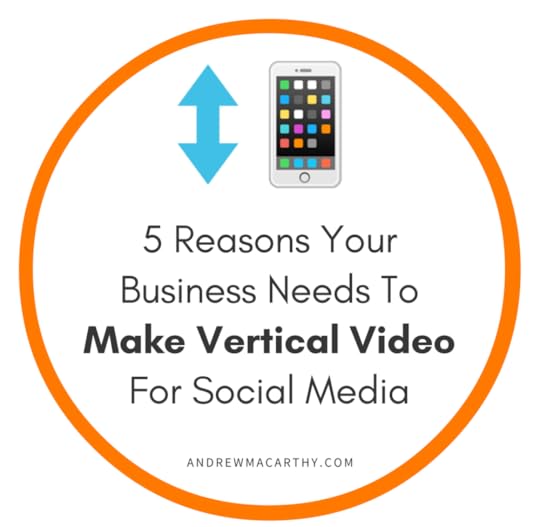
Does your business record vertical videos for social media? In years gone by, recording and uploading video with the camera held vertically was looked upon with ridicule - producing big black bars either side of the picture and a narrow viewing angle, guaranteed to turn viewers off - but times are changing. In this blog post, I'm going to lay out 5 reasons why your business should be experimenting with vertical video for social media marketing in 2017, and the benefits it can bring.
1. People naturally hold their phones vertically (duh!)Obvious, but important! If we strip smartphones back to their most basic function - giving users the ability to make and receive phone calls - the design of modern smarphones simply follows the tradition of "dumb" phones from decades past; that the device should be held vertically so that the user can speak and listen with minimal fuss. TV and cinema, meanwhile, the dominant visual media for so long, have demanded that the picture is viewed horizontally for the best experience. And so, despite all the things smartphones can now do, we're historically conditioned to hold phones vertically and view video horizontally. We've been stuck between two competing worlds, but times are changing. For some hard facts, look to the MOVR Mobile Overview Report from December 2014, which found, unsuprisingly, that smartphone users hold their phones vertically about 94% of the time.
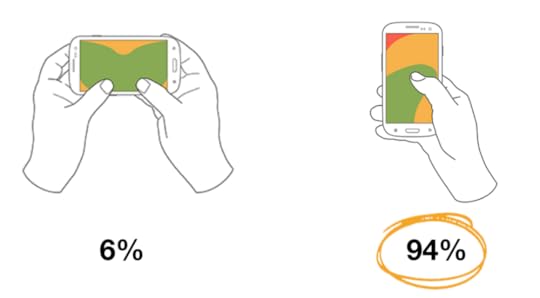
image credit: Form Meets Function http://formmeetsfunction.com/portfoli...
With the huge increase in mobile-recorded video content online in recent years, it's no surprise that vertical device usage also on the up. A 2016 study by KPCB Research showed that people in the US are now spending 29% of time using vertically-held devices, up from just 5% in 2010. And since people are holding these devices vertically for most tasks, it makes sense that they'll shoot video and play it back that way, too.
2. People access social media on mobile the most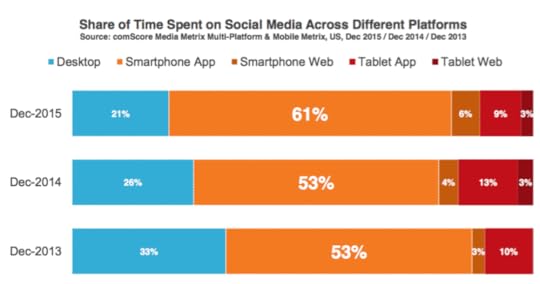
Not only are the vast majority of mobile apps designed with the assumption that users will be interacting while holding their smartphone vertically, but its increasingly where people are spending their time on social media. In comScore’s 2016 U.S. Cross-Platform Future in Focus study, it showed that nearly 80% of social media use now occurs on mobile devices - 61% on smartphones alone. In addition, by 2018 in the US, the gap between desktop and mobile Internet use is predicted to grow to people spending three hours and 20 minutes using the Internet on their phone, compared to just 40 minutes on the computer. As a business, your content needs to be built in a way that caters best to how it is being consumed.
3. Social networks are vertical video-friendlyIf we look at how vertical video renders on social apps, we see something interesting. As of February 2017:
Facebook: vertical videos publish with no black borders. Instagram: vertical videos publish with no black borders.Snapchat: vertical videos publish with no black borders.Twitter: vertical videos publish with no black borders.YouTube: The Android version of the app hides black borders when device is held vertically and video is viewed in full screen.Rather than looking upon vertical video as a negative, social networks - even YouTube - are embracing the format. There's no way they're going to be able force people to film in landscape mode without really annoying them(as YouTube used to do!), so why not make the viewing experience (inferior to landscape mode as it may be) as optimum as it can be? And there are other benefits. When it comes to watching live video, viewers holding their phones vertically can engage with reactions and comments in a way that is natural to them.
Rolling out the 2:3 ratio of vertical video on Facebook in August 2016 (rather than cropping vertical videos into squares), a Facebook representative told Marketing Land at the time: “We know that people enjoy more immersive experiences on Facebook, so we’re starting to display a larger portion of each vertical video in News Feed on mobile." Facebook wants people to stay on its site, so it will do whatever it can to suit their needs.
Instagram's roll-out of vertical video last year shared a similar sentiment. In a blog post to announce its Stories feature (boasting over 150 million users as of January 2017), it said: “Square format has been and always will be part of who we are. That said, the visual story you’re trying to tell should always come first, and we want to make it simple and fun for you to share moments the way you want to."
4. Vertical video ads convert better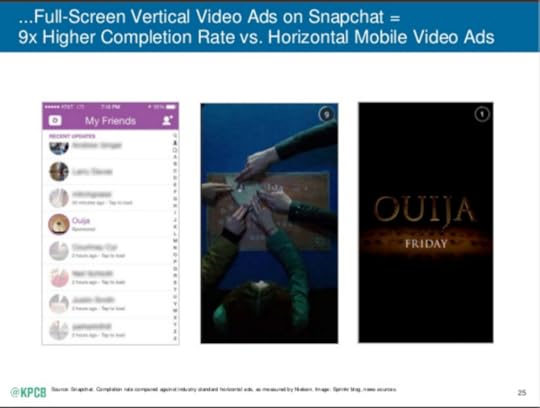
Vertical video ads are growing in favour with advertisers as well, and when you understand that's how the orientation in which users are increasingly consuming video, you see why. "From a storytelling perspective, this is obviously more exciting," said Dan Grossman, VP of platform partnerships at VaynerMedia told Mashable. "If we can take up more of the screen that means you're less distracted. We can capture more of the viewer's attention."
In another recent development, the launch of vertical video ads for Instagram Stories in January 2017, it seemed open to their success: “Since the beginning, we’ve been thoughtful about rolling out ads on Instagram to give businesses and consumers the best experience possible. And ad formats are no exception. Portrait has long been available on the platform for posts, and is a common format for consuming mobile content”.
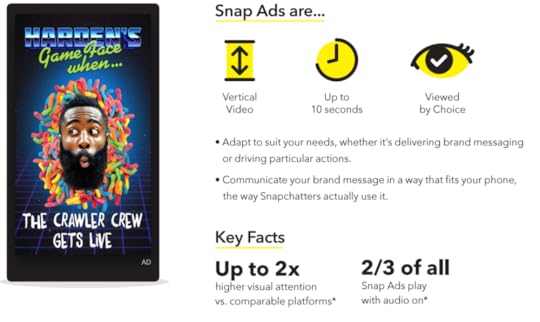
For more factual evidence, look to Snapchat, who you might say spearheaded the vertical video revolution in social media. In a pitch to publishers in 2015, it reported that full screen vertical video ad completion rates were 9x higher than those of horizontal video ads. The company's internal research also shows that vertical video ads draw up to 2x higher visual attention vs. comparable platforms - "Communicate your brand message in a way that fits your phone, the way Snapchatters actually use it."
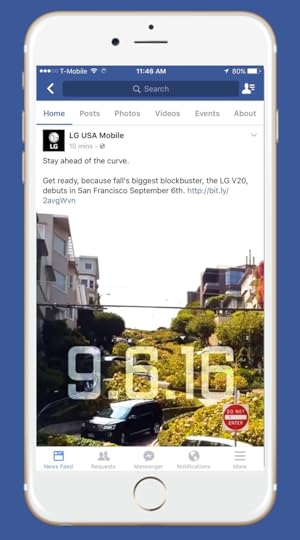
In addition, Jason Stein, CEO of Laundry Service, reported success with LG vertical video ads soon after their launch last year. He told Adweek that his had had been receiving CPM rates that were 3x more efficient than standard square videos on Facebook.
5. Your customers are lazyWhisper it, but it's true - and as customers ourselves, we're all guilty of it. Think of it like this: when users are zipping through mobile sites and social media feeds, they expect the experience to be seamless. If your video plays in landscape and can be viewed okay, not very many people are going to make the effort to turn their phone 90 degrees and tap to expand to full screen. It's lazy, but it's the truth. As a marketer, that means you're missing out on filling a users' screen with your ad and keeping their full attention as effectively as possible.
Perhaps this point is best summed up by Zena Barakat, a former New York Times video producer who spent a year researching vertical video. She discovered that many people didn’t reorient their phones to watch horizontal videos in full-screen mode. “As a person who makes videos, I was like, ‘You’re not seeing it the way we intended it!’” Ms. Barakat told the New York Times. “And they were like, ‘We don’t care!’ They found it so uncomfortable to hold the phone the other way, and they didn’t want to keep switching their phones back and forth.’”
Over to youWhat are your thoughts on the vertical video revolution? Will you be experimenting with vertical video on social for your brand? Let me know in the comments below!

Andrew Macarthy is a social media consultant and the author of the #1 Amazon Web Marketing Bestseller, 500 Social Media Marketing Tips.
Buy 500 Social Media Marketing Tips
Amazon US: http://www.amazon.com/dp/B007L50HE6
Amazon UK: http://www.amazon.co.uk/dp/B007L50HE6
Follow Me:
http://www.fa
cebook.com/50
0socialmediatips/
http://www.pinterest.com/andrewmacarthy
http://www.twitter.com/andrewmacarthy
January 25, 2017
6 New Facebook Page Features Your Business Needs to Know About in 2017

6 New Facebook Page Features Your Business Needs to Know About in 2017
With 2017 now in full swing, are you doing all you can to optimise your Facebook marketing strategy? A whole slew of new features were rolled between the end of last year and now - and some, you really can't afford to miss.
In this blog post, I'll be highlighting six new Facebook features that every brand needs to consider right now. Let's go!
1. Posting best practices for 2017As ever, the "what marketing strategy works best?" question for Facebook success has no one magic bullet, but using the latest research, it is possible to notice trends that might give you a leg-up on the competition. For example BuzzSumo's review of 800 million Facebook posts curated during 2016 highlighted some of the following tips:
Be brief: posts containing less than 50 characters were found to be the most engaging.Post off-peak: posts shared when then the Newsfeed is less busy received more engagement, on average.Use video: Video posts (live or recorded) receive more shares than all other post types.Ask questions: Questions got more likes than all other post types.
2. Optimise your cover photo for desktop and mobile
Facebook displays Page cover photos at 820 x 312 pixels on desktop, and 640 x 360 pixels on smartphones. This means, rather confusingly, that cover photos can appear differently on desktop and mobile. To ensure any text on your cover photo also displays on mobile (i.e. is not obscured or cropped), create an invisible buffer of 134 pixels either side, and feature the text in the middle - the remaining 560 pixels. Jon Loomer's infographic spells it out clearly below:
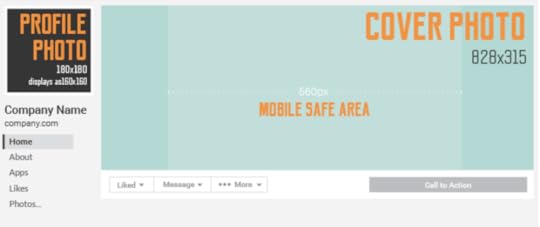
3. Setup Holiday and Custom Reminders
I usually recommend all businesses plan and schedule content in advance, but if you're one of those people who tends to post to Facebook on the fly, you might want want setup Reminders to make sure you don't miss out on special dates. Reminders will notify you about upcoming holidays, or you can setup your own by day and time. Says Facebook:
"We can remind you to update your page on days that are important to you. Regular posts build visitor trust and engagement, and reminders can make it easier to follow a posting schedule."
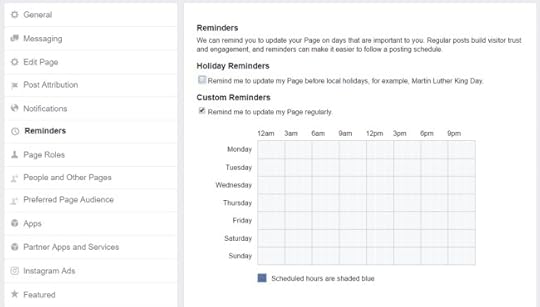
Where to find it: On your Page, visit Settings and click Reminders from the left-hand menu.
4. Change your profile photo to a videoAll profiles and some Pages can now record or upload a video of up to 7 seconds to use as a profile video, which will replace your current static profile photo and loop continously. Subtlety is perhaps the best approach for this feature - you still want users to be able to easily identify your brand name or logo. You can currently only add a profile video from iPhone or Android.
To add a profile video from iPhone:
1. Go to your profile and tap your profile picture or video
2. Tap Take a New Profile Video to take a new video or tap Select Profile Video to choose a video on your phone
3.Record a new video or select a video already on your phone
4. Tap Use
To add a profile video from Android:
1.Go to your profile and tap your profile picture or video
2.Tap Take a New Profile Video to take a new video or tap Select Profile Video to choose a video on your phone
3.Tap Next, then tap the bar at the bottom of the screen to choose a thumbnail for your video
4. Tap Use
When using social media on mobile, people prefer having the choice to opt in to sound on videos. Facebook's own research found that when mobile video ads play loudly when people aren’t expecting it, 80% of people react negatively, both toward the platform and the advertiser. You might take this as a notice to create video ads that do not require any sound at all to be understood. However, in cases where this isn't possible, you've always been able to manually add closed captions. Now, however, Facebook can automatically generate them in video ads.
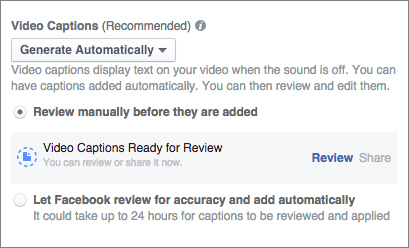
Automated captions are currently only available through Power Editor. When creating video ads in Power Editor, your video captions will be generated after uploading your video (it may take several minutes for them to appear).
To set them up:
1. Once your video ad has finished uploading, click Select.
2. Below Video Captions, you'll see a dropdown that says Generate Automatically.
3. If you've selected Generate Automatically, you'll see two options: Review manually before they are added or Let Facebook review for accuracy and add automatically. I'd recommend reviewing manually, just in case Facebook's audio detection isn''t quite in sync with your audio message.
If you haven't experimented with Facebook Live in a while, its most recent update introduces a number improvements that give brands more control and flexibility over live broadcasts, including:
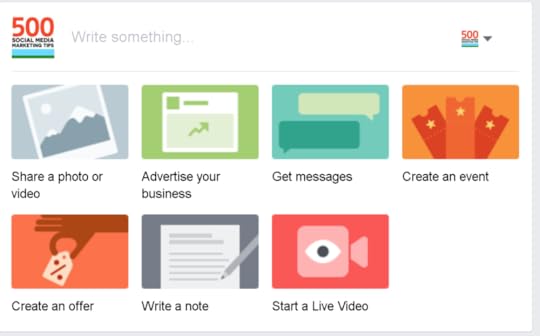
Broadcasting from a web browser: You can now go live on Facebook straight from the web on your desktop computer, not just from a mobile as was previously the case. All you need is a webcam and away you go. Where you compose a status, click on the "Start A Live Video" option.
Live contributors for Pages: A new "Live Contributor" role is now available in Pages, which will allow admins to give specific individuals the ability to broadcast live. Before this, only admins could go live from a Page. To add a new live contributor, visit the Assign a New Page Role section within Settings > Page Roles.
Enhanced video metrics: Profiles with at least 5,000 followers will receive enhanced insights on their live videos, including metrics on total minutes viewed, total number of viewers, total engagement, as well as aggregated insights for all videos over 7-,30-, and 60-day periods.
Over to youWhat are your thoughts on these new Facebook features for business? Which ones will you be putting to use in your own strategy? Let me know in the comments below!
December 14, 2016
Let's Get Popular on Instagram (A Follow-Along Guide For Brands): Part 1 - Introduction and Hashtag Analysis

Let's Get Popular on Instagram (A Follow-Along Guide For Brands): Part 1 - Introduction and Hashtag Analysis
Using Instagram for business? Want to grow your following and attract passionate new fans and customers? In this blog, I'll show you how to analyse your current Instagram hashtags ready to optimise them for maximum exposure. It's the first step in my own renewed ourney towards Instagram success, and I hope you can join in, too. First, though, a bit of background:
Why I'm Starting Instagram FreshI've long been fascinated with building an audience on Instagram, but after my initial "business" profile broke after I foolishly experimented with a tool that posted to Instagram from my desktop (hashtags ceased to function, against ToS, rendered account useless; won't be doing that again!), I concentrated my efforts back onto Facebook and Twitter and only used Instagram sporadically - until recently.
After several failed attempts at developing a consistent and coherent pattern of content and graphical style, I think I can finally say I'm ready to give it another really good go. I can't understate the importance of producing captivating photos and graphics for Instagram, and the hard graft of community engagement, too - and maybe I'll get into that more later on down the line - but for now, I'm comfortable I've found a formula that I can manage as far as content creation goes, and first will be looking at optimising my hashtag strategy - key, Instagram pros say, to attracting thousands of followers. This is Step 1.
In a previous post, I explained the importance of selecting the right hashtags on Instagram as a way to get your content discovered and to grow your Instagram following. I'd definitely recommend giving it a read so that the bulk of this post makes the most sense. In short, the strategy involves strategically choosing a variety of niche and popular hashtags to give yourself the best chance of being found in the top echelons of Instagram search, and in the top 9 Trendingimages/videos that are featured for several hours at the top of each search result.
Disclaimer and the reason for this project: I've only roughly followed my past advice on hashtag strategy, and am beginning to see some decent results. What follows, I hope, will be an over-the-shoulder journey into optimising my Instagram strategy to deliver more success - one that you can emulate for your own brand.
Step 1: Search Your Profile At SM Audience
At the time of writing, SM Audience offers a free Instagram analytics tool. Enter any Instagram username into its search bar, and the site will return a variety of valuable statistics, including:
number of followers and users you followaverage number of likes per postaverage number of commentsoverall engagement rate %Here's the search result of my account, @500socialmedia:
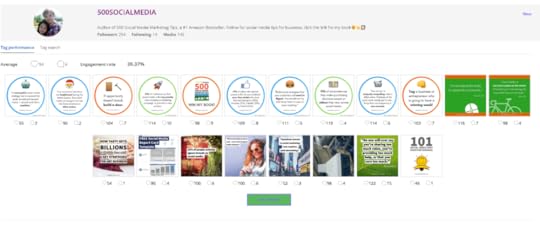
You'll also see an overview of all of your most recent posts, and how they have performed. Above is my most recent content, with an overall engagement rate of 39.37% - not too shabby. Also notice my new style in the latest 10 posts versus the mish-mash of styles before that.
Step 2: Analysing Instagram HashtagsAs mentioned, I'm happy with my content and its style - very important! Now, let's nail down on the hashtags. Clicking on any individual post will provide a list of all of the hashtags used, along with:
Density - the number of posts also using that hashtag in Instagram search.
Row - The row number that this post was found on in Instagram search. The higher the number, the lower down search we go.
Position: The position of this post in Instagram hashtag search. Posts with this hashtag are presented in chronological order, 3 across, left to right.
Top 9 - The position number for this post within the Top 9 section when searching for this hashtag.

In the example above, the post I have chosen is roughly three days old and one of my most successful of the past two weeks. It won't be getting much more engagement (unless I pay to promote it), so provides a good base for analysis. Importantly, the hashtags used are - give or take one or two - the same set that I have used for each and every post. Using the same set of hashtags for each post gives this hashtag strategy some much-need consistency. In other words, a bunch of random hashtags won't cut it! Let's take a closer look:
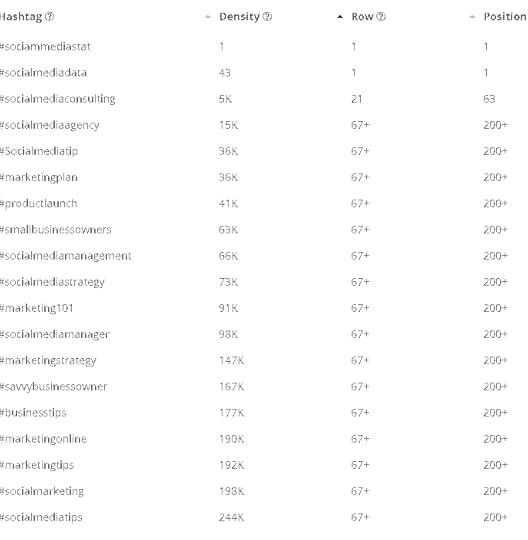
In the image above, I clicked the "up" arrow to sort the hashtags by density. Ideally, I want to be aiming to include a variety of hashtags that hit between the 10K and 200K range, give or take. Collective wisdom tells us that these will give my post the best chance of getting spotted at the top of search, and even included in the Top 9 featured posts within search results.
What the analysis tells us:
Out of 24 hashtags used (6 not shown, below fold), most sat within my desired Density range of between 10K and 200K hashtag search results. Good!The majority of these posts were well down the search results in terms of Row and Position, and none were featured in the Top 9. Of the top two hashtags that did get good Row and Position... well, no one else is using two of them. Bad!Next StepsThat's it for Part 1. My goal now is to keep posting consistently (one new post per day) and perform some more in-depth hashtag research. By studying the hashtags from other accounts within the social media marketing industry using SM Audience, I'll be looking to find a more even spread of niche and more popular hashtags between the 10K and 200K Density range, and using them in my own posts.
After a week has elapsed, I'll re-evaluate. In Part 2, I'll share with you my success (I hope), or failure. Perhaps you'll join me on this journey by re-evaluating or building your own Instagram audience using the same method as above. Hope to see you along the way!
Current Statistics - December 14th, 2016.
Followers: 252
Following: 14
Posts: 145

Andrew Macarthy is a social media consultant and the author of the #1 Amazon Web Marketing Bestseller, 500 Social Media Marketing Tips.
Buy 500 Social Media Marketing Tips
Amazon US: http://www.amazon.com/dp/B007L50HE6
Amazon UK: http://www.amazon.co.uk/dp/B007L50HE6
Follow Me:
http://www.fa
cebook.com/50
0socialmediatips/
http://www.pinterest.com/andrewmacarthy
http://www.twitter.com/andrewmacarthy



